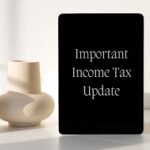Introduction
As March 2024 approaches, salaried employees find themselves at a crucial juncture for tax planning. With the end of the financial year looming, now is the ideal time to assess and implement strategies that can optimize tax liabilities. This blog will guide salaried individuals through a comprehensive checklist of actions to take before the closing of March 2024, helping them make informed decisions and maximize their tax savings.
1. Review Your Income and Investments
Start by assessing your total income for the financial year. This includes your salary, bonuses, and any other additional income. Once you have a clear picture of your earnings, evaluate your existing investments, such as provident funds, fixed deposits, and equity investments. Understanding your financial landscape is the first step toward effective tax planning.
2. Utilize Section 80C Deductions
Section 80C of the Income Tax Act provides a range of investment options that are eligible for deductions up to ₹1.5 lakh. Consider maximizing your contributions to instruments like Public Provident Fund (PPF), Employee Provident Fund (EPF), Equity-Linked Saving Schemes (ELSS), National Savings Certificate (NSC), and tax-saving fixed deposits. Allocate your investments strategically to make the most of this deduction.
3. Explore NPS Benefits
The National Pension System (NPS) offers an additional deduction of up to ₹50,000 under Section 80CCD(1B). By contributing to the NPS, you not only save for your retirement but also reduce your taxable income. Evaluate your financial goals and consider making additional contributions to the NPS to avail of this extra tax benefit.
4. Assess Health Insurance Coverage
Health insurance premiums paid for yourself, spouse, children, and parents are eligible for deductions under Section 80D. Ensure that you have adequate health insurance coverage and consider topping it up if needed. Additionally, if you are paying premiums for your parents who are senior citizens, you can claim a higher deduction. Evaluate different health insurance plans to find the most suitable and cost-effective option.
5. Maximize HRA Benefits
If you live in a rented accommodation, make sure you are maximizing the benefits of House Rent Allowance (HRA). Submit rent receipts to your employer and ensure that the rent agreement is in place. If you have not declared HRA earlier in the year, consider doing it now to avail of the tax benefits.
6. Submit Investment Declarations to Your Employer
To ensure that your employer considers your investments for tax calculation, submit your investment declarations promptly. This will help in adjusting your tax liability at the source and prevent excess TDS deductions. Provide accurate details of your planned investments, including those under Section 80C, 80D, and other applicable sections.
7. Optimize Salary Restructuring
Evaluate the possibility of restructuring your salary to minimize your tax liability. Components like special allowances, reimbursements, and bonuses can be optimized to achieve the most tax-efficient structure. Consult with your HR department to explore options that align with your financial goals and contribute to overall tax savings.
8. Claim Tax Benefits on Home Loan Repayments
If you have taken a home loan, you are eligible for tax benefits on both the principal repayment (under Section 80C) and the interest paid (under Section 24). Ensure that you claim these benefits to the fullest extent. If you have recently purchased a house, make sure you provide the possession certificate to claim deductions on the pre-possession interest paid.
9. Evaluate Tax Implications of Other Perquisites
Salaried employees often receive various perquisites, such as a company car or stock options. Understand the tax implications of these benefits and explore ways to optimize their impact on your overall tax liability. For instance, if you have a company car, consider the tax implications of personal use and explore options to minimize the taxable value.
10. Assess Tax-Efficient Investment Options
Beyond the traditional tax-saving instruments, explore other investment options that offer tax efficiency. Tax-saving mutual funds (ELSS) and unit-linked insurance plans (ULIPs) are examples of instruments that combine tax benefits with the potential for wealth creation. Conduct thorough research or consult with a financial advisor to determine the best options based on your risk tolerance and financial goals.
11. Keep Track of Section 80G Donations
If you have made donations to eligible charitable institutions, ensure that you claim deductions under Section 80G. Keep all relevant receipts and documentation handy to support your claims. This not only contributes to a noble cause but also helps in reducing your taxable income.
12. Stay Informed About Recent Tax Amendments
Tax laws are subject to change, and staying informed about recent amendments is crucial for effective tax planning. Keep an eye on budget announcements and updates from the Income Tax Department to ensure that you are leveraging the latest provisions for tax savings.
Conclusion
As March 2024 approaches, salaried employees have a unique opportunity to optimize their tax liabilities through strategic planning. By carefully reviewing their income, investments, and available deductions, individuals can make informed decisions to maximize tax savings. Implementing the suggested actions in this comprehensive checklist will not only reduce tax burdens but also contribute to long-term financial well-being. Remember, proactive tax planning is not just about saving money; it’s about making smart financial choices that align with your broader financial goals.






